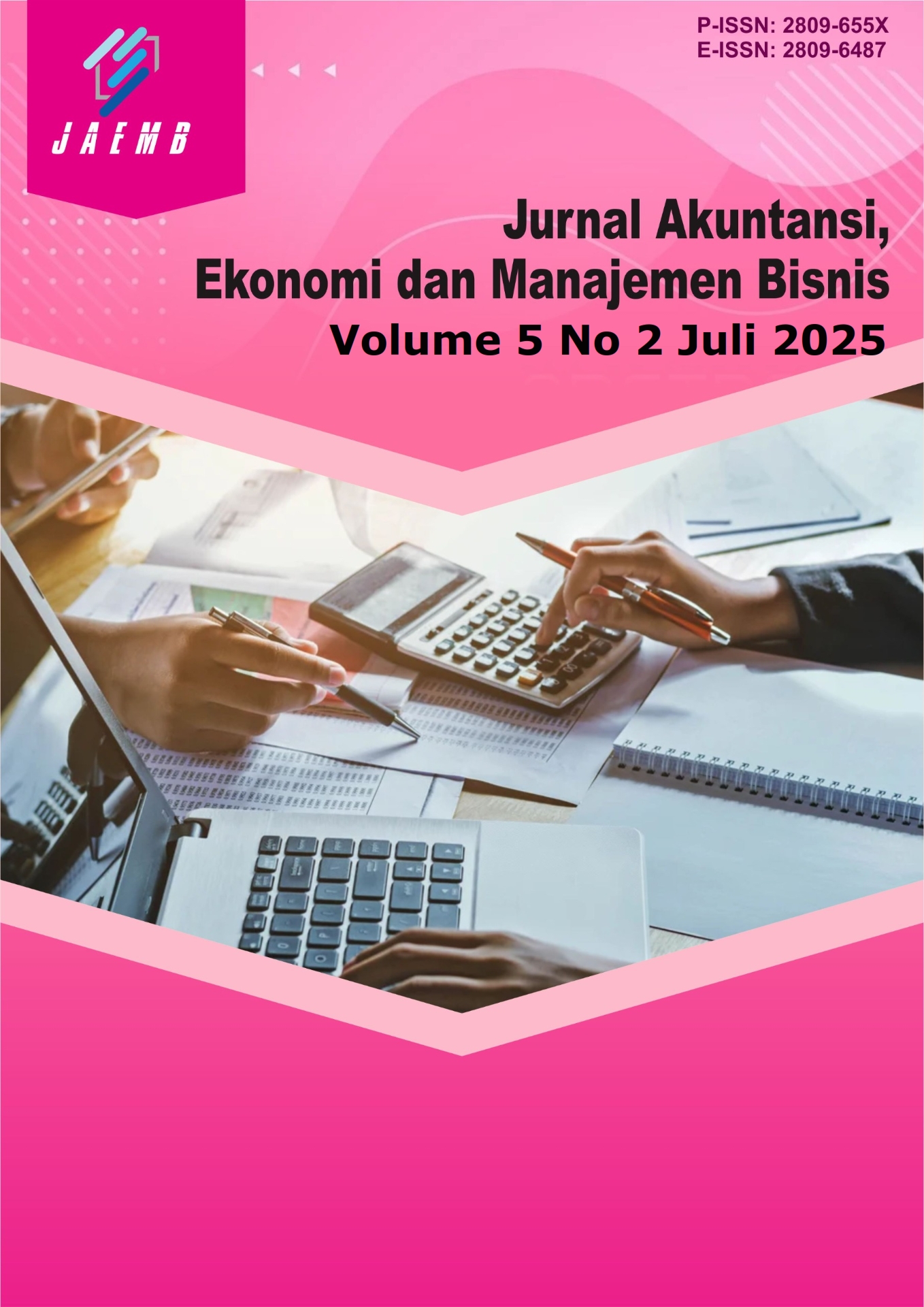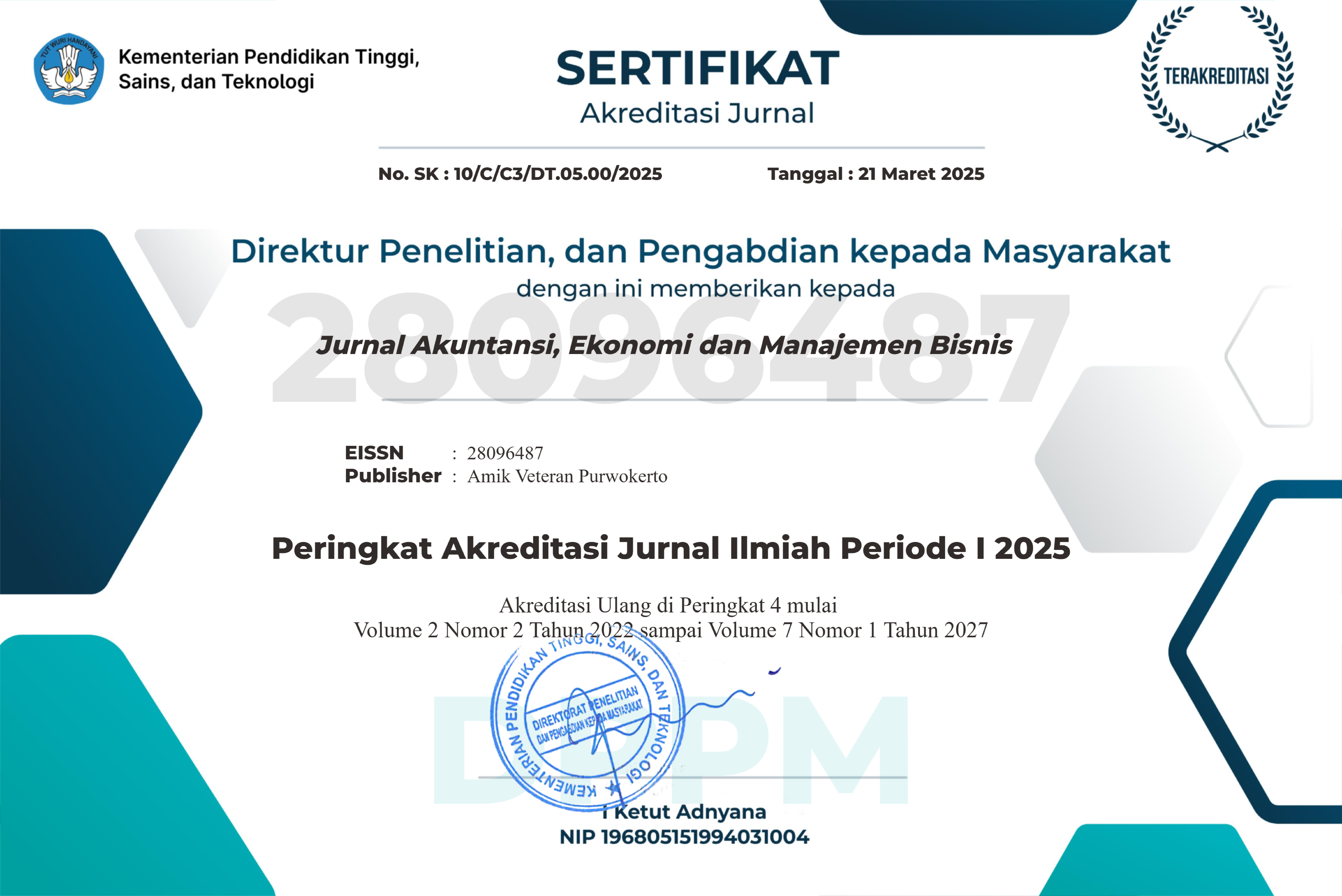Stewarding Shariah Finance: A Contemplative Reappraisal in Islamic Banking Across the ASEAN-6 Polity
DOI:
https://doi.org/10.55606/jaemb.v5i2.6083Keywords:
sharia accounting, asean-6, islamic bankingAbstract
This study examines the impact of four core Shariah compliant financing instruments, Mudharabah, Murabahah, Musharakah, and Ijarah, on the profitability of Islamic banks in the ASEAN-6 region, measured by Return on Assets (ROA). Using panel data from 20 Islamic banks across six countries (2020–2024), the study applies multiple regression analysis and classical assumption testing to ensure statistical robustness. Where contract disclosures were incomplete, data forecasting methods were applied. The findings indicate that Mudharabah, Murabahah, and Musharakah significantly enhance ROA, with Mudharabah showing the most pronounced effect, while Ijarah has no significant influence. These results support the relevance of Shariah Enterprise Theory, highlighting the role of ethical and participatory contracts in achieving profitability and Islamic economic justice. The study contributes novel insights by integrating Islamic worldview theory with empirical analysis across multiple jurisdictions. It also underscores the importance of incorporating ‘uqud murakkabah (hybrid contracts) and adopting digital innovations such as blockchain and smart contracts to improve transparency, mitigate risks, and strengthen Islamic financial infrastructure in alignment with Maqasid al-Shariah and sustainability objectives.
Keywords: ASEAN-6; Islamic Banks; Profitability; Shariah Finance
References
[1] Addury, M. M. (2023). Do financing models in Islamic bank affect profitability? Evidence from Indonesia and Malaysia. Journal of Islamic Economics Lariba, 9(1), 79–96. https://doi.org/10.20885/jielariba.vol9.iss1.art5
[2] Amar, A. Ben, & Alaoui, A. O. El. (2022). Profit- And Loss-Sharing Partnership: The Case of the Two-Tier Mudharaba in Islamic Banking. International Journal of Islamic and Middle Eastern Finance and Management, 16(1), 81–102. https://doi.org/10.1108/imefm-12-2020-0630
[3] Amri, M. A. (2022). SDM Perbankan Syariah di Brunei Darussalam. Attanmiyah: Jurnal Ekonomi Dan Bisnis Islam, 1(2), 115–129. https://creativecommons.org/licenses/by-sa/4.0/
[4] Anjum, M. I. (2022). An Islamic critique of rival economic systems’ theories of interest. International Journal of Ethics and Systems, 38(4), 598–620. https://doi.org/10.1108/IJOES-08-2021-0155
[5] Aulia Fitria Yustiardhi et al. (2020). Issues and Challenges of the Application of Mudarabah and Musharakah in Islamic Bank Financing Products. Journal of Islamic Finance, 9(2 SE-Articles), 26–41. https://doi.org/10.31436/jif.v9i2.482
[6] Bahakhiri, H., & Leniwati, D. (2022). Analisis Perbandingan Kinerja Keuangan Antara Bank Islam Thailand Dengan Bank Umum Periode 2017-2019. Muhammadiyah Riau Accounting and Business Journal, 3(1), 40–49. https://doi.org/10.37859/mrabj.v3i1.2786
[7] Bahri, S. (2022). Pengaruh Pembiayaan Murabahah, Mudharabah, Dan Musyarakah Terhadap Profitabilitas. JAS (Jurnal Akuntansi Syariah), 6(1), 44–60. https://doi.org/10.46367/jas.v6i1.502
[8] Baloch, B. A., & Chimenya, A. (2023). Ethical Dimensions of Islamic Finance and Their Relevance in Contemporary Business Practices. International Journal of Islamic Banking and Finance Research, 11(2), 32–39. https://doi.org/10.46281/ijibfr.v11i2.2125
[9] Basir, K. H. (2022). Business Innovation Amid the COVID-19 Crisis in Brunei Darussalam: A Viewpoint. In V. Ratten (Ed.), Strategic Entrepreneurial Ecosystems and Business Model Innovation (pp. 31–40). Emerald Publishing Limited. https://doi.org/10.1108/978-1-80382-137-520221003
[10] Caccioli, F. et al. (2014). Stability analysis of financial contagion due to overlapping portfolios. Journal of Banking & Finance, 46(10), 233–245. https://doi.org/https://doi.org/10.1016/j.jbankfin.2014.05.021
[11] Chausson, A. et al. (2023). Going beyond market-based mechanisms to finance nature-based solutions and foster sustainable futures. PLOS Climate, 2(4), 169–199. https://doi.org/10.1371/journal.pclm.0000169
[12] EL-Ansary, O., & Al-Gazzar, H. (2021). Working capital and financial performance in MENA region. Journal of Humanities and Applied Social Sciences, 3(4), 257–280. https://doi.org/10.1108/JHASS-02-2020-0036
[13] El, I. M. et al. (2022). The Effect of Mudharabah and Musyarakah Financing on Profitability of Islamic Banks in Indonesia. Indonesian Interdisciplinary Journal of Sharia Economics (IIJSE), 5(1), 225–234.
[14] Febiola, V. et al. (2023). Pengaruh Kepuasan Nasabah Terhadap Loyalitas Nasabah Pengguna Produk Tabungan Easy Wadiah Pada PT. Bank Syariah Indonesia Tahun 2022. Jurnal Akuntansi, Manajemen, Bisnis Dan Teknologi (AMBITEK), 3(1), 97–104. https://doi.org/10.56870/ambitek.v3i1.73
[15] Ghozali, I. (2018). Aplikasi Analisis Multivariate dengan Program IBM SPSS 25 Edisi 9. Badan Penerbit Universitas Diponegoro.
[16] Hadi, E. S. (2024). Dinamika Pasar Keuangan Syariah Dan Konvensional Di Indonesia: Perspektif Volatilitas Dan Stabilitas. Jurnal Ekonomi Utama, 3(3), 404–412. https://doi.org/10.55903/juria.v3i3.223
[17] Hakim, A. (2021). Peluang Dan Tantangan Lembaga Keuangan Syariah Indonesia Pada Era Pasar Bebas Asean. Jurnal Keislaman, 2(2), 217–237. https://doi.org/10.54298/jk.v2i2.3387
[18] Hartati, D. S. et al. (2021). Pengaruh Pembiayaan Mudharabah, Musyarakah Dan Ijarah Terhadap Profitabilitas Bank Umum Syariah Di Indonesia. Jurnal Ilmiah Ekonomi Islam, 7(1), 235. https://doi.org/10.29040/jiei.v7i1.1836
[19] Hassan, M. K. et al. (2023). Ijarah: The Second Contract in HPSM BT - Hire Purchase Under Shirkah al-Milk (HPSM) in Islamic Banking and Finance: A Shari’ah Analysis. In M. K. Hassan et al. (Eds.), Ijarah: The Second Contract in HPSM (pp. 53–81). Springer Nature Switzerland. https://doi.org/10.1007/978-3-031-50105-0_3
[20] Ibrahim, N., & Sapian, S. M. (2023). Does Tawarruq still remain the top option for Islamic home financing (IHF) products in Malaysia? Qualitative Research in Financial Markets, 15(1), 160–189. https://doi.org/10.1108/QRFM-07-2021-0118
[21] IFDI. (2024). Islamic Finance Development Report 2024 (Issue November).
[22] IFSB. (2024). IFSB Stability Report 2024. https://www.ifsb.org
[23] Indriastuti, M., & Najihah, N. (2020). Improving Financial Performance Through Islamic Corporate Social Responsibility and Islamic Corporate Governance. Jurnal Riset Akuntansi Dan Bisnis Airlangga, 5(1), 818. https://doi.org/10.31093/jraba.v5i1.206
[24] Iqbal, M. et al. (2024). Determinants of Islamic bank stability in Asia. Journal of Islamic Accounting and Business Research, 1(1), 123–135. https://doi.org/10.1108/JIABR-07-2022-0174
[25] Irwan, I., & Harthi, K. (2024). Pengaruh Boikot Produk Israel Terhadap Pola Konsumsi Mahasiswa UINSI Samarinda. Mushawwir Jurnal Manajemen Dakwah Dan Filantropi Islam, 2(2), 22–44. https://doi.org/10.21093/mushawwir.v2i2.8753
[26] Khoiruman, M., & Wariati, A. (2023). Analisa Motivasi Boikot (Boycott Motivation) Terhadap Produk Mc Donald Di Surakarta Pasca Serangan Israel Ke Palestina. Excellent, 10(2), 247–257. https://doi.org/10.36587/exc.v10i2.1582
[27] Kismawadi, E. R. (2024). Contribution of Islamic banks and macroeconomic variables to economic growth in developing countries: vector error correction model approach (VECM). Journal of Islamic Accounting and Business Research, 15(2), 306–326. https://doi.org/10.1108/JIABR-03-2022-0090
[28] Maulana, A. (2023). Analisis Perbandingan Kinerja Keuangan Perbankan Syariah Di Asean Melalui Pendekatan Islamicity Performance Index. Jurnal Bisnisman : Riset Bisnis Dan Manajemen, 4(3), 12–28. https://doi.org/10.52005/bisnisman.v4i3.116
[29] Meutia, I. (2010). Shari ’ Ah Enterprise Theory Sebagai Dasar Pengungkapan Tanggungjawab Sosial.
[30] Musa, M. A. et al. (2020). Islamic business ethics and practices of Islamic banks: Perceptions of Islamic bank employees in Gulf cooperation countries and Malaysia. Journal of Islamic Accounting and Business Research, 11(5), 1009–1031. https://doi.org/10.1108/JIABR-07-2016-0080
[31] Musthafa, T. F. et al. (2020). Application of Asset Revaluation By the Public Assessment Office: a Reflection of Sharia Accounting, Shari’Ah Enterprise Theory. International Journal of Economics, Business and Accounting Research (IJEBAR), 4(03), 16–26. https://doi.org/10.29040/ijebar.v4i03.1281
[32] Naim, N., & Kasri, N. S. (2025). Intellectual Property and Islamic Finance: Opportunities and Challenges for a New Islamic Intellectual Property Finance Framework. Thunderbird International Business Review, 67(3), 395–412. https://doi.org/10.1002/tie.22430
[33] Nata, A. A. L. et al. (2023). Tinjauan Historis : Kemajuan Sistem Perbankan Syariah Yang Ada Di Asia Tenggara. Margin: Jurnal Bisnis Islam Dan Perbankan Syariah, 2(1), 64–83. https://doi.org/10.58561/margin.v2i1.85
[34] Nawawi, A. et al. (2018). Pengaruh Pembiayaan Mudharabah dan Musyarakah Terhadap Profitabilitas (ROA) Pada BPRS HIK Bekasi Kantor Cabang Karawang. Falah: Jurnal Ekonomi Syariah, 3(2), 96–105. https://doi.org/10.22219/jes.v3i2.7679
[35] Nst, M. Z. A., & Nurhayati. (2022). Teori Maqashid Al-Syari’Ah Dan Penerapannya Pada Perbankan Syariah. Jesya : Jurnal Ekonomi & Ekonomi Syariah, 5(1), 899–908. https://doi.org/10.36778/jesya.v5i1.629
[36] Oberoi, D. S., & Dhingra, H. (2003). Simple Temperature Indicator Uses RISC-Based MCU. Electronic Design, 51(19), 67–68.
[37] Othman, N. et al. (2023). Equity Financing and Islamic Bank Stability: Evidence From Malaysia and Indonesia. International Journal of Islamic and Middle Eastern Finance and Management, 16(6), 1248–1268. https://doi.org/10.1108/imefm-03-2022-0106
[38] Pratama, D. N. et al. (2017). Pengaruh Pembiayaan Mudharabah, Pembiayaan Musyarakah, dan Sewa Ijarah Terhadap Profitabilitas. JRKA: Jurnal Riset Keuangan Dan Akuntansi, 3(1), 53–68. https://doi.org/10.1108/02635570210428311
[39] Putri, R. D. (2020). Pengaruh Pembiayaan Murabahah Dan Musyarakah Terhadap Profitabilitas Bank Umum Syariah Periode 2016-2018. Jurnal Tabarru’: Islamic Banking and Finance, 3(1), 48–56. https://doi.org/10.25299/jtb.2020.vol3(1).5310
[40] Rahmawati, M. et al. (2020). Islamic Worldview : Tinjauan Pemikiran Syech Muhammad Naquib Al-Attas dan Budaya Keilmuan Dalam Islam. NALAR: Jurnal Peradaban Dan Pemikiran Islam, 4(2), 77–91. https://doi.org/10.23971/njppi.v4i2.2165
[41] Rama, A. (2018). Studi Komparasi Regulasi Tata Kelola Syariah Bagi Perbankan Syariah Di Negara-negara Muslim Minoritas. Al-Masraf (Jurnal Lembaga Keuangan Dan Perbankan), 3(2), 133–145.
[42] Ramli, R. et al. (2024). Shariah Contracts in Private Equity and Its Prospect for Small and Medium Enterprises (SME). PaperASIA, 40(5), 165–179. https://doi.org/10.59953/paperasia.v40i5b.217
[43] Rangkuti, A. (2017). Konsep Keadilan Dalam Perspektif Islam. Tazkiya : Jurnal Pendidikan Islam, 6(1), 1–21.
[44] Rayuanda, E., & Thamrin, H. (2022). Epistemologi Ekonomi Syariah. Syarikat: Jurnal Rumpun Ekonomi Syariah, 5(2), 93–100. https://doi.org/10.25299/syarikat.2022.vol5(2).9627
[45] Romadhon, M. R., & Ardiansyah, M. (2022). Analisis Pasar Modal Syariah 5 Negara Asean di Era Pandemi COVID 19. E-Journal Ekonomi Bisnis Dan Akuntansi, 9(1), 36. https://doi.org/10.19184/ejeba.v9i1.30412
[46] Samsu. (2017). Metode Penelitian: Teori dan Aplikasi Penelitian Kualitatif, Kuantitatif, Mixed Methods, serta Research and Development. In Diterbitkan oleh: Pusat Studi Agama dan Kemasyarakatan (PUSAKA) (1st ed.). Pustaka Jambi.
[47] Sari, C. I. P., & Sulaeman, S. (2021). Pengaruh Pembiayaan Murabahah, Pembiayaan Mudharabah dan Pembiayaan Musyarakah Terhadap Profitabilitas. Al Maal: Journal of Islamic Economics and Banking, 2(2), 160–180. https://doi.org/10.31000/almaal.v2i2.3111
[48] Sari, N. I., & Nuraini, A. (2022). Pengaruh Pembiayaan Mudharabah, Murabahah, dan Ijarah Terhadap Laba Bersih (Studi Kasus pada Bank BRI Syariah periode 2016-2020). Jurnal Ilmiah Akuntansi Kesatuan, 10(2), 221–232. https://doi.org/10.37641/jiakes.v10i1.1322
[49] Selasi, D. et al. (2022). Pertumbuhan Bank Syariah di ASEAN: Dalam Sejarah The Growth of Islamic Banks in ASEAN: In History. Ecobankers : Journal of Economy and Banking, 3(2), 157–171. https://journal.bungabangsacirebon.ac.id/index.php/EcoBankers/article/view/623
[50] Shaikh, S. A. (2023). Some observations on contemporary financial proposals. International Journal of Ethics and Systems, 39(2), 464–480. https://doi.org/10.1108/IJOES-03-2021-0067
[51] Siddik, M. Y. (2025). Independensi Perbankan Syariah Dalam Promosi Produk Berbasis Syariah. Jurnal At-Tamwil: Kajian Ekonomi Syariah, 7(1 SE-Articles), 29–45. https://doi.org/10.33367//at.v7i1.1505
[52] Soediro, A., & Meutia, I. (2018). Maqasid Sharia As A Performance Framework For Islamic Financial Institutions. Jurnal Akuntansi Multiparadigma, 9(1), 70–86.
[53] Solikin, A. B. et al. (2022). Implementasi Sifat Shiddiq Dalam Pelaksanaan Prinsip Transparansi GCG Pada Lembaga Keuangan Syariah. Jurnal Ekonomika Dan Bisnis (JEBS), 2(1), 887–892. https://doi.org/10.47233/jebs.v2i3.326
[54] Suharto, U. (2018). Riba and interest in Islamic finance: semantic and terminological ıssue. International Journal of Islamic and Middle Eastern Finance and Management, 11(1), 131–138. https://doi.org/10.1108/IMEFM-08-2016-0109
[55] Susanto, P. C. et al. (2024). Konsep Penelitian Kuantitatif : Populasi , Sampel , dan Analisis Data ( Sebuah Tinjauan Pustaka ). 3(1), 1–12.
[56] Syauqina, A. H. (2024). Hukum Humaniter Internasional Terhadap Anak Korban Perang Palestina dan Israel. Ethics and Law Journal: Business and Notary, 2(3), 142–148. https://doi.org/10.61292/eljbn.222
[57] Tamam, A. M. (2017). Islamic Worldview : Paradigma Intelektual Muslim (2nd ed.). Spirit Media.
[58] Triyuwono, I. (2001). Metafora Zakat dan Sharia Enterprise Theory sebagai Konsep Dasar dalam Membentuk Akuntansi Syariah. Jurnal Akuntansi Dan Auditing Indonesia, 5(2).
[59] W Jubilee, R. V. et al. (2022). Does globalisation have an impact on dual banking system productivity in selected Southeast Asian banking industry? Asia-Pacific Journal of Business Administration, 14(4), 479–515. https://doi.org/10.1108/APJBA-09-2020-0343
[60] Wahyuni, N. et al. (2023). Analisis Komparasi Kinerja Keuangan Bank Umum Syariah Asia Tenggara Dengan Pendekatan Islamicity Performance Index. Jambura Accounting Review, 4(1), 89–103. https://doi.org/10.37905/jar.v4i1.67
[61] Wan Ahmad Ikram, W. A. S. (2018). Ownership Risk in the Perspective of Islamic Law of Contract: Concept and Application on Modern Practices. Journal of Islamic Economic Laws, 1(1), 31–52. https://doi.org/10.23917/jisel.v1i1.6342
[62] Widanti, N. R., & Wirman, W. (2022). Pengaruh Pembiayaan Mudharabah, Musyarakah dan Ijarah Terhadap Profitabilitas (ROA) Pada Bank Umum Syariah di Indonesia. Jurnal Ilmiah Ekonomi Islam, 8(1), 308. https://doi.org/10.29040/jiei.v8i1.4592
[63] Yasin, H. et al. (2022). Islamic Worldview. Jurnal Pendidikan Islam, 5(1), 2721–2521.
[64] Yurmaini, Y., & Anshari, K. (2022). the Meaning of the Siddiq Value in Financial Accountability At the University of Muslim Nusantara (Umn) Al Washliyah Medan. Proceedings of the 1st International Conference on Social Science (ICSS), 1(1), 205–221. https://doi.org/10.59188/icss.v1i1.30
[65] Zarkasyi, H. F. (2023). Worldview Islam dan Kapitalisme Barat. Jurnal Tsaqafah, 9(1), 15. https://doi.org/10.21111/tsaqafah.v9i1.36
Downloads
Published
How to Cite
Issue
Section
License
Copyright (c) 2025 Jurnal Akuntansi, Ekonomi dan Manajemen Bisnis

This work is licensed under a Creative Commons Attribution-ShareAlike 4.0 International License.








